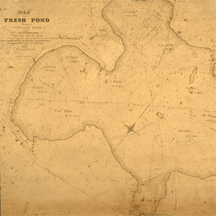 |
|||

|
Frederick Tudor “The Ice King of New England” was one of the most prominent Boston merchants in the early 19th century. Beginning in 1805, Tudor harvested ice from across Massachusetts at places including Haggett's Pond in Andover, Spy Pond in Arlington, Sandy Pond in Ayer, Fresh Pond in Cambridge, Walden Pond in Concord, Suntaug Lake in Lynnfield, Spot Pond and Doleful Pond in Stoneham, Lake Quannapowitt in Wakefield, Horn Pond in Woburn, and Wenham Lake in Wenham. The ice was then shipped to cities in the United States, as far south as Charleston and New Orleans, and even as far as the West Indies. Ice that was cut from the ponds of New England in January and February reached the furthest destinations a few months later, but in only very small amounts. Haphazardly cut with only rudimentary storage, most of all ice shipped melted before it reached its final destination. Despite the expense and the failures, people around the world wanted Frederick Tudor’s ice because it was a rare luxury in the pre-industrialized world. It was the only means of keeping foods cool and drinks refreshing in the summer months. Clients from restaurants, markets, dairies, breweries, and meat packing businesses all needed Frederick Tudor’s ice. Without ice, food spoiled rapidly and bacterial infections were common. Perhaps even more importantly, hospitals relied on ice to cool both patients and medications. As reigning ice king, Tudor had an established business, but he soon was able to make his ice company into an empire with help from a little-known employee. Nathaniel Jarvis Wyeth was the son of the proprietor of the Fresh Pond Hotel in Cambridge. He was born in 1802 and grew up learning the management of his father’s hotel. During the winters, the hotel’s off season, Wyeth worked for Frederick Tudor, stocking the ice houses with the ice from Fresh Pond and insulating it for travel with sawdust. In his first winter as manager of the Fresh Pond ice fields in 1825, Wyeth developed a horse-drawn ice cutter which allowed for the previously haphazard blocks of ice to be cut, and then stored, with uniform precision. It has been estimated that this device reduced the cost of harvesting winter ice from thirty cents per ton to ten cents per ton. His invention as well and the increased efficiency it afforded the ice company, made both Tudor and Wyeth wealthy men. It was not only his ice cutter, but his experiments with insulating materials and new ice houses which decreased melting losses from 66 percent to less than 8 percent that make Wyeth such an important innovator. He made ice harvesting faster, storage more effective, and shipping easier, all while reducing waste. The improvements allowed Tudor to successfully ship ice around the world to Cuba, the West Indies, Calcutta, India, South America, China, and England. Records indicate that even Queen Victoria purchased ice from Tudor in the 1840s. Tudor, however, was a successful businessman, and not one to allow too much freedom to his star employee. In a few years time, Wyeth felt restrained by the Tudor ice fields, inspired by his friend Hall Kelley, organized a joint-stock company, to trade for furs on the Columbia River. Plagued by inexperience and bad luck, his two attempts met with failure. Wyeth returned to Massachusetts in 1836, and reentered the ice shipping business, in which he was successful until his death in 1856. The impact of Nathaniel Wyeth’s contributions to the commercial ice industry are astounding. During his lifetime, he held fourteen patents relating to the cutting and transportation of ice. His innovations were not limited to the the business of Frederick Tudor, however. Between 1847 and 1862, Boston’s ice consumption increased from 27,000 to 105,000 tons, and by 1879 there were 35 commercial ice plants in America. Ice boxes, often filled with Massachusetts ice, sat in most American homes until the 1920s when electric refrigeration eliminated the need for the ice harvesting industry. For posterity’s sake, the Dictionary of American Biography makes it clear just how monumental Nathaniel Wyeth’s achievements were, explaining:, "[I]t was said at his death that practically every implement and device used in the ice business had been invented by Nat Wyeth." Sources: |
||

